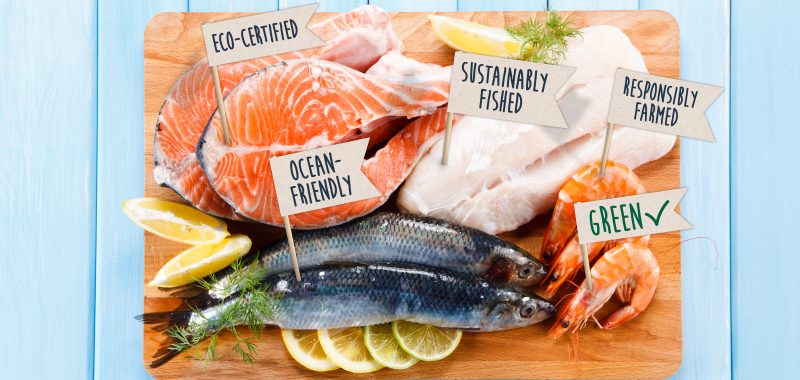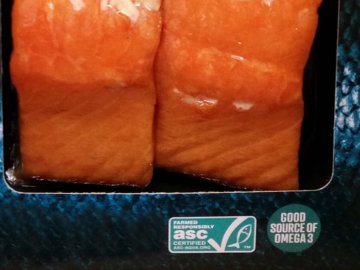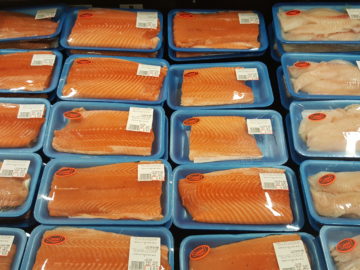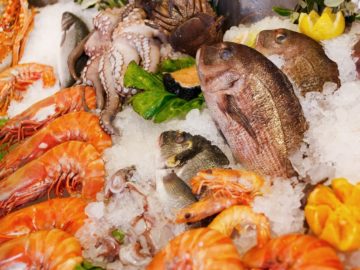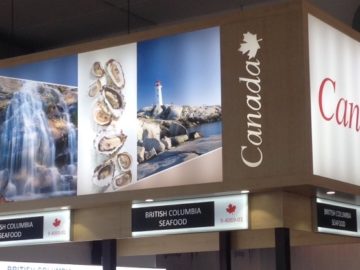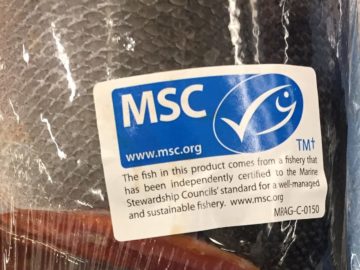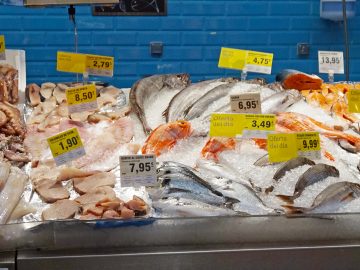Seafood eco-labels can help you buy products that are environmentally sustainable and socially responsible.
A few weeks ago, SeaChoice hosted representatives from Canada’s major retailers to an online webinar on the differences between seafood eco-labels. The aim was to alleviate any confusion caused by the ever-increasing array of seafood eco-labels in the market. Our webinar was directed at large-volume seafood buyers, but there are some key differences among types of eco-labels that smaller-volume buyers, like you and me, should be aware of too.
There are three main categories of seafood eco-labels: eco-certifications, rankings and recommendations, and self-claims. This article will only discuss the environmental aspects of seafood eco-labels, but as my colleague highlighted in a recent article, an increasing number of organizations are developing methods to assess social responsibility and reflect it in eco-labels.
Eco-certifications
The primary distinguishing characteristic of eco-certifications, compared to other types of eco-labels, is that they assess fisheries or farms against a published standard or set of requirements, and assessments are carried out by independent, third-party companies hired by the fishery/farm. The assessments are peer-reviewed and also made available for stakeholder input. Some certification schemes, like the Marine Stewardship Council (MSC) and Aquaculture Stewardship Council (ASC) also require every actor along the supply chain to be certified against their Chain of Custody Standard, which results in very high confidence that the product you buy in store is what you think it is.
However, while robust eco-labels like MSC and ASC can help you spot environmentally sustainable products, certification is voluntary (and quite expensive, especially for small producers) and the majority of fisheries and farms don’t have these certifications, so they aren’t always easy to find in Canada.
Fortunately, there are other eco-labels that can help you choose sustainably produced, but non-certified, products.
Rankings and recommendations
There have been many different ranking systems developed to suit markets around the world, but the most common in Canada are the Ocean Wise Seafood Program developed by the Vancouver Aquarium and Seafood Watch rankings developed by our southern neighbors at the Monterey Bay Aquarium.
Seafood ranking and recommendation programs work by scoring the sustainability of a fishery or farm. They usually rely on published methodologies to justify their judgments, and like eco-certifications, assessments are peer-reviewed and made available for stakeholder comments. Consumer-facing programs will make their recommendations freely available on their website, on mobile apps, or on paper handouts. You will need detailed information regarding the seafood in question in order to use these tools (more on this below). Some programs also allow their logo to be used on seafood products or on menus, such as the Ocean Wise Recommended logo.
Fisheries or farms generally don’t get a say in whether they are ranked by these programs – decisions are typically driven by product importance to the market. This means a wider range of seafood is ranked, compared to eco-certified. This makes rankings useful when trying to figure out which kinds of seafood are particularly worrisome from an environmental point of view, for example products in Seafood Watch’s ‘Avoid’ category.
In contrast to the eco-certifications programs outlined above, ranking and recommendation programs generally don’t include traceability requirements. This means retailers or restaurants need to have their own system in place to make sure the products they are buying are what they think they are.
Another consideration with ranking programs is that due to Canada’s lax labelling laws, which only require seafood labels to include a common name (and for imported products, the country of last major processing), you may not have enough information to use the program. A seafood’s rank or rating depends on which species it is, how it was produced, and where it was produced. SeaChoice’s ongoing studies into seafood labels in Canada shows that products usually aren’t labelled with any of this information. We are actively working with the Canadian government to raise standards and with Canadian retailers to improve labelling voluntarily.
Self-claims
Finally, there’s one more type of eco-label you might see on your seafood – especially if you’re buying frozen or canned products – and that’s self-claims.
Self-claims are either logos or slogans on seafood products that a company has developed on their own. Self-claims might refer to the company’s sourcing policy or set of sourcing standards, or they might refer to nothing at all. Some businesses’ provide details on their websites, but the details can be ambiguous. For example, one company’s eco-label is stated to represent a commitment to sourcing from “MSC-certified fisheries, fisheries under MSC pre-assessment or fisheries identified for Fishery Improvement Projects”. The last category could mean very little in terms of sustainability. Fisheries identified by who? Have they started on the project or are they just identified as needing to? What are the goals of the improvement project, and are they actually making progress? How much of this product is being sourced from each category?
This lack of clarity, and the fact that most are neither independently verified nor traceable, means it can be hard to know how sustainable these products truly are.
SeaChoice and eco-labels
Recently, SeaChoice has been taking a close look at eco-certifications to see if the fisheries and farms they are certifying actually live up to their standards. This is because we believe in the potential they have to bring positive changes to practices on the water, particularly because of the joint market power of retailers and other industry actors who have committed to using them.
Now that we have a good understanding of where these eco-labels are at, we are going to be turning our attention to the other types of eco-labels, especially self-claims. Stay tuned for the results of our first census of self-claims on seafood products sold in Canada’s major grocery stores.
And next time you find yourself in the seafood aisle, take a look at the packaging. How many eco-labels can you see? Is it clear what they mean? If you’re not sure, find a staff member to ask. And if they aren’t sure, choose something else.
